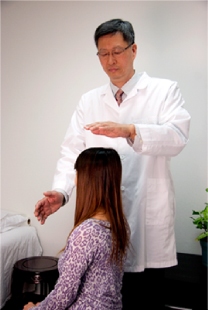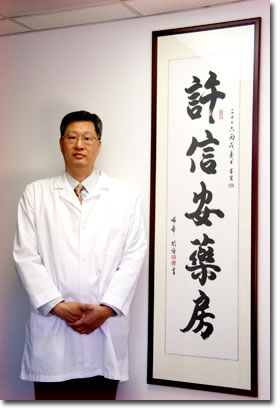Our Services
- Overview
- QiGong FAQ
- Acupuncture FAQ
- Herbs FAQ

The healing process begins the moment the patient steps into the waiting room of CTA Healing Center. The waiting room is quiet and cozy, allowing for the patient to be at ease. After the patient lies down on treatment bed, Dr Sheu will conduct the information scanning Diagnosis, visualize the human body from a distance without the help of any instruments, and obtain information feedback from patients systems.It is quick and straightforward, with no need for patients to provide medical history or laboratory reports. Dr Sheu will share the health reading and discuss the treatment plan with patient.
When the treatment starts, Dr. Sheu stands beside the bed and motions his hand a short distance from the patient’s body, emitting healing “qi” into the patient. The healing qi (bioenergy) cleanses and detoxifies the patient’s body, which restores circulation and optimizes the immune system performance.
According to World Health Organization, third quarters of world population face health conditions and complications. This mean most people have multiple chronic symptoms. It is important not to simply alleviate the symptoms, but rather to fix the root cause of them; otherwise, symptoms will just recur. That is why Dr. Sheu's qigong treatment is effective: to cleanse the body, it reactivates the immune system to heal itself, rather than depending on external medicine to help the body.
A treatment cycle of 5 visits in two weeks time frame is ideal to achieve this purpose. Back to back treatment within 5 days is proven to help patient tremendously in more severe circumstances. Dr Sheu discusses follow up treatment plans during the 5th visit. For patient who face multiple symptoms, a second treatment cycle for 5 more visits with different intervals may be necessary. As human health is dynamics, future visits may be necessary to prevent the development of new symptoms if the root issue is not yet fixed.
In between the appointments, DrSheu may suggest to take Chinese herbs and/or practice qigong. Both approaches can enhance the healing process. The Chinese herbs that the CTA Healing Center uses are of the highest quality of concentrated herbs from GMP manufacturers; all are approved and inspected by the FDA.
Dr. Sheu will prescribe based on symptoms and customize the formula. The herbs are in capsule form and come with clear instructions.
The qigong taught by Dr Sheu is Informatic Healing Qigong, with its main focus on healing and detox. It was created by legendary Qigong Master Zhao Xue-Zhong and has been learned by thousands of people around the world for over thirty years. Although it is the most advanced medical healing qigong, it does not require complicated movements or much time to practice. It can be learned in hours and 30 minutes a day to practice, with most patience seeing immediate results.
QiGong FAQ (5)
The answers on most common questions are described bellow.
Qi also acts as the life force, and the total absence of Qi is akin to death. Every aspect of good health depends on a balanced distribution of Qi throughout the channel network that influences the organs and bodily systems: skeletal, muscular, endocrine (glands), circulatory, digestive, respiratory, urinary, reproductive, and nervous. When Qi flows smoothly and harmoniously throughout the meridians, each bodily system and organ operates harmoniously as an independent, interrelated, and integrated unit.
During its long history, Qigong developed into hundreds of different kinds of practices for different purposes in China. Some focus on external strength, like Shaolin temple’s; some focus on meditation, such as Zen Qigong; some focus on retrospective purposes, such as Taoist or Buddhist practices; and finally some specifically focus on medical healing, like Informatics Qigong.
Informatics Qigong emphasizes self-healing. It is simple, and effective. Its methods have provided proven results to tens of thousands of Qigong learners in China.
During a Qigong Healing treatment, the patient remains clothed and lies down comfortably. Matthew may carry on a conversation with the patient while directing the "healing Qi". Matthew will ask for the patient’s feedback from time to time in a casual manner.The patient may experience sensations of Qi---heat, cold or air waves rushing out from their feet. Some may experience a gentle jolt of electricity at the focus areas as the body goes through the process of detoxification.
In addition to those diseases treatable through acupuncture, Qigong Healing especially addresses:
gout, arthritis, rheumatoid arthritis
chronic gastroenteritis, peptic ulcer, gastroptosis, indigestion, loss of appetite, abdominal bloating
amenorrhea, inadequate postpartum complications, mammary gland hyperplasia
edema, prostatitis, kidney stones
eczema, hives, food poisoning
chemo/radiation poisoning
angina, heart palpitation, arrhythmia, chest pain and tightness
chronic head blow injuries
post-concussion syndrome, post-surgical complications
Acupuncture FAQ (12)
The answers on most common questions are described bellow.
At CTA Healing Center, we also provide the “Needle-free Treatments” ----Qigong or energy healing.
The following is a partial list of ailments the acupuncture can treat. If yours is not on this list please call to find out if Acupuncture is appropriate for you.
Addictions, Allergies, Asthma, Anxiety, Arthritis, Back pain, Bladder problems, Bronchitis, Chemotherapy, Childhood illnesses, Common cold, Constipation, Cough, Depression, Diarrhea, Dizziness, Fatigue, GERD, Headache, High blood pressure, High cholesterol, IBS, Immune deficiency
Herbs FAQ (6)
The answers on most common questions are described bellow.
Skin disease, including eczema, psoriasis, acne, rosacea, urticarial
Gastrointestinal disorders, including irritable bowel syndrome, chronic constipation, ulcerative colitis
Gynaecological conditions, including premenstrual syndrome( PMS) and dysmenorrhoea, endometriosis, infertility
Hepatitis and HIV: some promising results have been obtained for treatment of Hepatitis C
Chronic fatigue syndromes, whether with a background of viral infection or in other situations Respiratory conditions, including asthma, bronchitis, and chronic coughs, allergic and perennial rhinitis and sinusitis
Rheumatological conditions (e.g. osteoarthritis and rheumatoid arthritis)
Urinary conditions including chronic cystitis
Diabetes, including treatment and prevention
Psychological problems (e.g. depression, anxiety)
